Showing 1-20 of 29 results

Resources and Case Studies for Implementing Prairie Strips Across the Midwest
Compared to other Conservation Reserve Program practices, prairie strips (CP43) offer many advantages. Prairie strips can be placed both within fields and along their edges. Planting 10% of fields to prairie strips can reduce sediment and nutrient loss. The practice is flexible, with the option of driving on strips when needed for farm operations. And […]
Introduction to Ecological Outcomes Verification: Short-Term Monitoring
This Michigan State University course is designed to teach the foundations of short-term monitoring through the use of Ecological Outcomes Verification (EOV). EOV is a practical and scalable soil and landscape assessment methodology that tracks outcomes in biodiversity, soil health, and ecosystem function (water cycle, mineral cycle, energy flow and community dynamics). EOV applies to […]
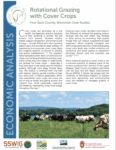
Rotational Grazing with Cover Crops Case Studies
Since rotational grazing of cover crops is not a common practice, to address some of the current questions from farmers in the upper Midwest, the Sand County Foundation of Wisconsin partnered with the Sauk Soil and Water Improvement Group and the University of Wisconsin-Madison to explore short-term agronomic and environmental costs and benefits of managed […]

Strawberry Chat Podcast
Strawberry Chat is a virtual discussion about strawberry production at small and diversified farms in Indiana and neighboring states. The hosts, Wenjing Guan and Miranda Purcell of Purdue University, invite guests to discuss activities that happen at the time of the year and cover different production systems. URL: https://anchor.fm/strawberrychat
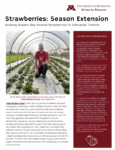
Strawberries: Season Extension
This University of Minnesota publication shares the experiences of two farmer who tried growing day neutral strawberries in high tunnels using a table top system. It shares their experiences in the areas of production, yield and marketing, with a budget analysis. The farmers are Todd and Tracy Linbo, of Double T Acres, and Aaron Wills, […]
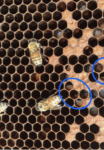
Diagnostic Tools for Honey Bee Diseases
Diagnostic Tools for Honey Bee Diseases is an interactive website designed to train beekeepers and veterinarians in honey bee medicine. It includes photos of honey bee diseases and clear instructions for known diagnostic methods for honey bee disease. Lessons include step by step instructions, common mistakes and even fun games to solidify learning objectives. This […]
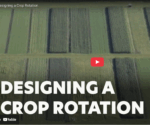
Organic Field Crop Production Videos
The following videos walk farmers through sustainable concepts and practices for organic weed control, including crop rotations and cultivation techniques. The videos highlight farmer perspectives on these topics and are part of a larger organic field crops course, available at https://courses.organicagronomy.org. Designing a Crop Rotation The concept of crop rotation is not new to organic […]
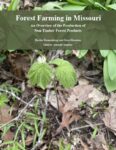
Forest Farming in Missouri An Overview of the Production of Non-Timber Forest Products
"Forest Farming in Missouri" is comprehensive guide to forest farming written to support landowners, producers, and professionals interested in this practice

South Dakota Innovators Build Affordable DIY Roller-Crimper
Ryan Schmid with the Ecdysis Foundation worked with farmers in South Dakota on a do-it-yourself guide and videos for repurposing a disc into a low-cost roller-crimper.

Beekeeping in Northern Climates Manual and Guidebook
The "Beekeeping in Northern Climates" Manual and Workbook are companion resources created by the University of Minnesota's Bee Lab to help beekeepers understand and apply region-specific best practices. Beekeeping in Northern Climates Manual The third edition of Beekeeping in Northern Climates is a manual from the University of Minnesota Bee Lab for both new and experienced beekeepers […]

Video Series Highlights How Different Field Practices Impact Moisture and Temperature
Researchers at Ohio State University conducted a multi-year study using soil moisture and temperature sensors to compare the effects of conventional tillage, no-till, and no-till with cover crops on field conditions.
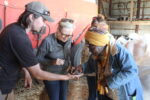
The New Growers’ Guide to Producing Organic Food-Grade Grains in The Upper Midwest
This guide is intended for farmers interested in adding food-grade grains to their rotations, whether they are new to farming, or interested in incorporating these grains into an existing commodity grain, diversified vegetable, or livestock operation.

Blooms for Mason Bees
With support from SARE, the Osmia Bee Company in Ohio is designing a seed mix to support springtime pollinators — particularly mason bees. They developed a guide with the intention that the information could be used as a starting point and adapted for other field trials. This project leverages the rich collaborative network maintained by […]
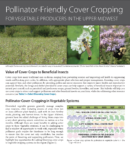
Pollinator-Friendly Cover Cropping for Vegetable Producers in the Upper Midwest
Growers are increasingly interested in adding cover crops to rotations to improve soil health, break disease cycles, and provide ecosystem services. In addition to these benefits, cover crops present an opportunity to add crucial floral resources and habitat for pollinators and other beneficial insects on the farm. However, identifying appropriate cover crop species and management […]

The Fruit and Nut Compass
The Fruit and Nut Compass is a farm business planning tool to help both new and experienced producers project the financial costs and returns from an enterprise focused on perennial crops.
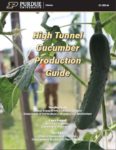
High Tunnel Cucumber Production Guide
This cucumber production guide provides resources and recommendations tailored to the distinctive growing environment of high tunnels.

Cottage Food: Launch a Bakery from Your Farm Kitchen
A farmer-led team in Wisconsin created resources to help farmers diversify their income by selling baked goods.
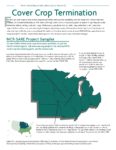
Cover Crop Termination
Farmers use cover crops to slow erosion, improve soil health, enhance water availability, smother weeds, help control pests and diseases, and increase biodiversity on their farms. Although cover crops can be partially grazed or used as forage, they are usually terminated before planting production crops. While row crop producers tend to prefer using herbicides to terminate, most vegetable/horticulture crop producers employ tillage as their primary means of termination. Some organic no-till producers use roller-crimpers to kill the cover crop and leave the mulch on the soil surface to conserve water. NCR-SARE has supported various research projects that have explored the advantages and limits of various cover crop termination strategies.

Handbook for Agroforestry Planning and Design
The steps provided in the Handbook for Agroforestry Planning and Design will allow you to identify what agroforestry products can grow on your land, which of these products you can sell profitably, and how to develop basic business and marketing strategies.
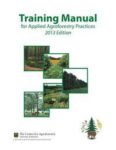
Training Manual for Applied Agroforestry Practices
The Training Manual for Applied Agroforestry Practices helps to explain agroforestry practices and their applications. It is designed for natural resources professionals and landowners, and includes worksheets and exercises for use as an educational tool. Additionally, the manual is designed to assist in the decision process so that, when established or managed, the agroforestry practice is most effective at achieving the desired objectives.